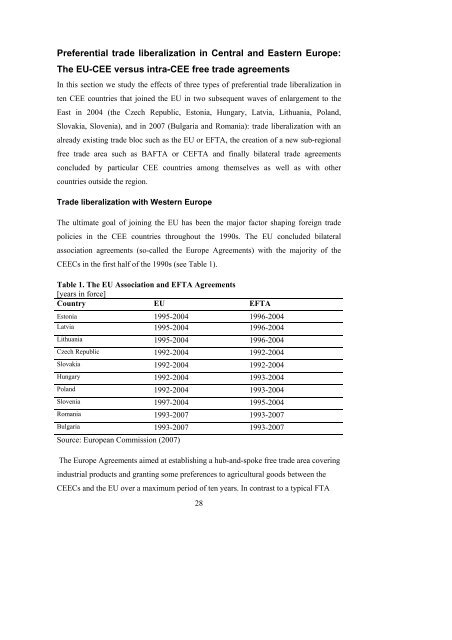PDF, GB, 139 p., 796 Ko - Femise
PDF, GB, 139 p., 796 Ko - Femise
PDF, GB, 139 p., 796 Ko - Femise
You also want an ePaper? Increase the reach of your titles
YUMPU automatically turns print PDFs into web optimized ePapers that Google loves.
Preferential trade liberalization in Central and Eastern Europe:<br />
The EU-CEE versus intra-CEE free trade agreements<br />
In this section we study the effects of three types of preferential trade liberalization in<br />
ten CEE countries that joined the EU in two subsequent waves of enlargement to the<br />
East in 2004 (the Czech Republic, Estonia, Hungary, Latvia, Lithuania, Poland,<br />
Slovakia, Slovenia), and in 2007 (Bulgaria and Romania): trade liberalization with an<br />
already existing trade bloc such as the EU or EFTA, the creation of a new sub-regional<br />
free trade area such as BAFTA or CEFTA and finally bilateral trade agreements<br />
concluded by particular CEE countries among themselves as well as with other<br />
countries outside the region.<br />
Trade liberalization with Western Europe<br />
The ultimate goal of joining the EU has been the major factor shaping foreign trade<br />
policies in the CEE countries throughout the 1990s. The EU concluded bilateral<br />
association agreements (so-called the Europe Agreements) with the majority of the<br />
CEECs in the first half of the 1990s (see Table 1).<br />
Table 1. The EU Association and EFTA Agreements<br />
[years in force]<br />
Country EU EFTA<br />
Estonia 1995-2004 1996-2004<br />
Latvia 1995-2004 1996-2004<br />
Lithuania 1995-2004 1996-2004<br />
Czech Republic 1992-2004 1992-2004<br />
Slovakia 1992-2004 1992-2004<br />
Hungary 1992-2004 1993-2004<br />
Poland 1992-2004 1993-2004<br />
Slovenia 1997-2004 1995-2004<br />
Romania 1993-2007 1993-2007<br />
Bulgaria 1993-2007 1993-2007<br />
Source: European Commission (2007)<br />
The Europe Agreements aimed at establishing a hub-and-spoke free trade area covering<br />
industrial products and granting some preferences to agricultural goods between the<br />
CEECs and the EU over a maximum period of ten years. In contrast to a typical FTA<br />
28

















